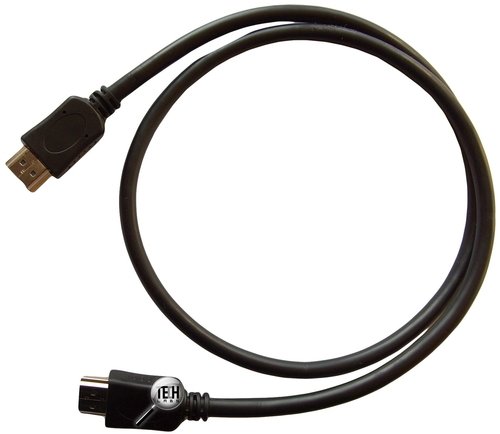We have already tested several affordable HDMI cables of SVEN Company as well as we have compared them with elite patterns at the price of approx. USD 1000. This time SVEN BASE cables of ultra affordable category were delivered to our laboratory. All cables have quite small, but honestly indicated cross-section – 30 AWG. The length of cables is 0.75, 1.5 and 2.5 meter. HDMI High Speed support has been declared for all cables and their cost is not high – about USD 2, 2.3 and 3 for 0.75, 1.5 and 2.5 meter versions accordingly.
Design and materials
All cables delivered for testing have had no package at all and looked quite identically, except for their lengths. Most likely, we’ll see an ordinary branded package at retail. In outward appearance, cables look simply to the utmost. Polymer, external isolation material, is soft, the cable is very pliable, it coils in rings easily. The cross-section AWG 30 is marked on the isolation and the compliance with HDMI High Speed standard.
Plugs are made of hard PVC, there are no inscription on them at all except HDMI logotype. There are no neither gilt, nor far more often used titanium nitride coating on contacts. It is unlikely to consider that as a disadvantage taking into account its scanty price. But at that, the quality of plugs are quite high, traces of press-forms are pronounced minimally.
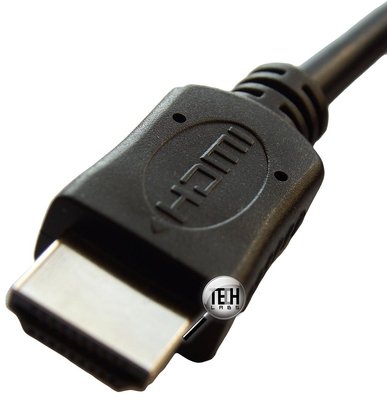
The moment of truth, however, comes only after the isolation dissection and examination of the cable design. Actually, High Speed marking means the cable belonging to the second category. The standard regulates values of signal attenuation, internal screening availability, as well as 28 AWG cross-section at the length of 5 meters. For a cable less than one meter long in principle there is no a necessity for a similar cross-section, and the reality is that AWG 30 cross-section is enough at the competent execution. But the ability of longer cables to operate with High Speed standard gives rise to some doubt.
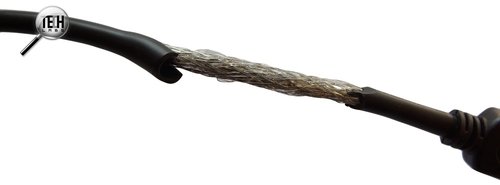
The construction of all three cables is totally identical. The outward grid shield of the cable is located beneath the closely fitting isolation, which appeared quite thin. The second layer of the outward shield – aluminum foil – is isolated from the internal shield by thin dielectric film.
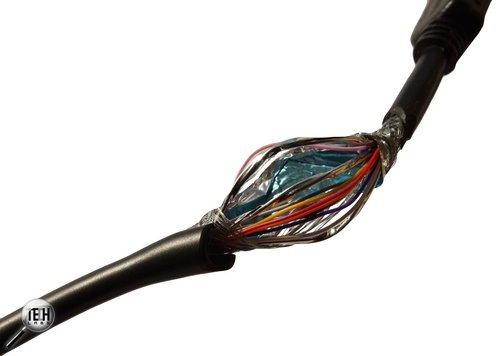
The internal screening is made of four twisted pairs. The mutual isolation of internal shields is absent, as well as the common copper cable, as it has been realized, for example, in a SVEN cable with rotary plugs.
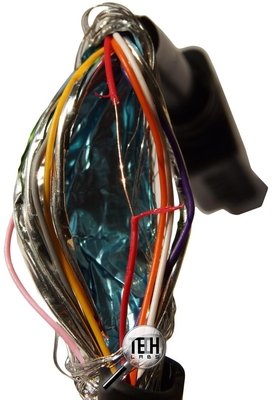
Copper cores have a diameter about 0.1 (± 001) mm, therefore the general cross-section area is approximately equal to 0.054 sq. mm, that is even a little bit more than AWG 30 (however, the diameter error could affect in that case).
When in use
HDMI cable of High Speed category must transmit the picture 1080p 60 Hz without problems, and that we have checked using a source – PlayStation 3 and Dune HD1 player connected to plasma Full HD Panasonic 50GT30 TV-set via Onkyo TX-NR579 receiver. It is worth noting that plasma Full HD panels with maximum cut-off of image processing are quite sensitive to problems of HDMI cable, which become apparent in the form of digital “snow” both white and colored on the black filling background.
Let’s start with the shortest 0.75 m cable. To tell the truth, we expected unpleasant surprises from so inexpensively cable even taking into account its small length (“dissection” was done after the test with AV equipment), and therefore we were ready to see the “snow” described above. However, the cable has demonstrated no problems at all in any mode (1080p, 1080i, 720p with frequency 24, 29.97, 30, 50 and 60 Hz) required for the full-fledged operation. We have not made direct comparisons with more expensive cables, because even the previous test has demonstrated that the picture and sound differences even at the difference in price in 500 times remains at the level of nuances. The customer of an expensive home theatre in any case will not pay attention to a cable at the price of $ 2, but a user of a small TV-set (for example, in the kitchen) will hardly be a client of a company, which produces laces for $ 500-1000 for one meter.
Honestly speaking, the testing of 0.75 m cable on 50” plasma panel was a “gross violation” of the producer’s recommendation. It is written on the package that HDMI BASE cables are designed for TV-sets up to 40”. Nevertheless, both 1.5 m and 2.5 m cables reproduced the picture in 1080р mode without breakups even on the plasma 50” TV-set. On the other hand, for justice’ sake, I have to say that the insufficient detail was felt in shadows and if to approach close to the screen, the “digital noise” was noticeable on the dark background in the form of accidentally emergent and going out sub-pixels in 1080p mode. But I want to emphasize that the testing on a 50” plasma panel is a super hard test, which has been passed by all cables adequately, but on LCD Sony KDL-40x3000 TV-set all three cables have been worked out all necessary modes without artifacts.
Conclusion
BASE High Speed HDMI cables have demonstrated their ability to operate according to High Speed HDMI standard. Their internal construction is of quite high quality – a double shield is available and copper cores by the cross-section correspond to declared values, the only disadvantage is the internal twisted pairs are not shielded in full and the intershield isolation is absent. However, this nuance is lost absolutely against the background of a scanty price and quite qualitative external manufacturing. Nevertheless, for home theatres of a class higher than the initial one we would recommend to buy cables with bigger cross-section. In any case, taking into consideration their price we do not have claims to SVEN Base HDMI High Speed cables, we can recommend with certainty to use them with 40” LED TV-sets.

